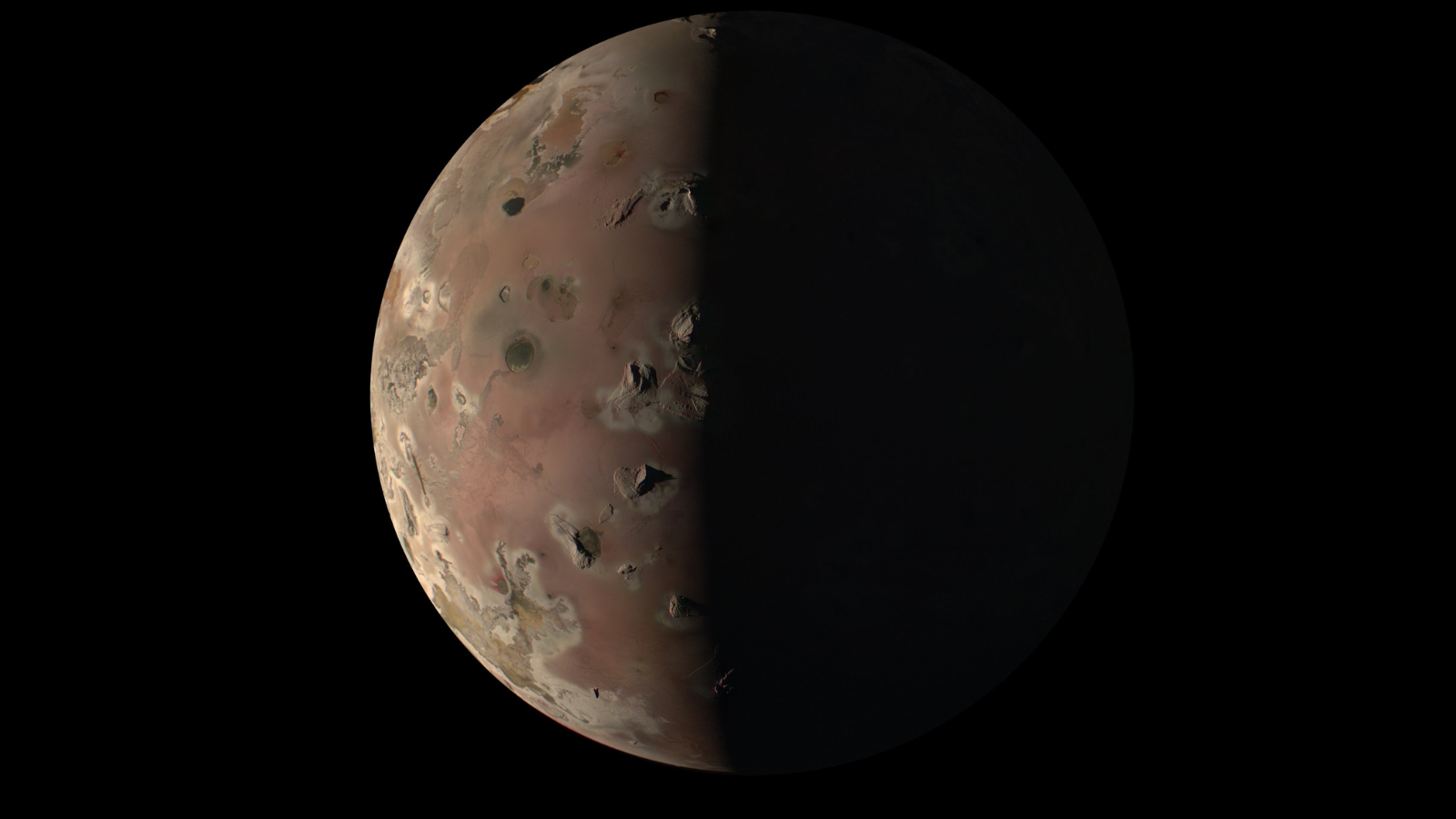NASA Juno spacecraft reveals Jupiter's volcanic moon Io like never before in spectacular new images
Juno ended 2023 in style, coming closer to the volcanic moon on Dec. 30 than any mission has for 20 years.

During its 57th flyby of Jupiter, NASA's Juno spacecraft came closer to the planet's moon Io than any other mission has in the last two decades.
Passing within around 930 miles (1,500 kilometers) of Io, the most volcanic body in the solar system, on Saturday, Dec. 30, 2023, Juno was able to capture stunningly detailed images of the Jovian moon. The only time a spacecraft has come closer to Io was in 2001, when NASA's Galileo spacecraft passed 112 miles (181 kilometers) above Io's south pole.
Juno, which launched on August 5, 2011, and reached Jupiter and its system of moons on July 4, 2016 — after a 1.7 billion-mile (2.8-billion-kilometer) journey — captured six views of Io to cap off 2023 in style. Some are black and white while others are in color. The purpose of the close passage wasn't just to take some incredible images, however, but also to collect important data about Io and its volcanism.
"By combining data from this flyby with our previous observations, the Juno science team is studying how Io's volcanoes vary," Scott Bolton, Juno's principal investigator and a scientist at the Southwest Research Institute, said in a statement issued prior to the flyby. "We are looking for how often they erupt, how bright and hot they are, how the shape of the lava flow changes, and how Io's activity is connected to the flow of charged particles in Jupiter’s magnetosphere."
Related: Massive, months-long volcanic eruption roils Jupiter's moon Io
NASA shared some of the incredible Io images on its X feed. In relation to a striking monochrome image of the highly volcanic moon, the space agency wrote: "The JunoCam instrument aboard our #JunoMission acquired six images of Jupiter's moon Io during its close encounter today. This black-and-white view was taken at an altitude of about 1,500 miles (2,500 kilometers)."
Io gets its status as the solar system's most volcanic body as a result of the immense gravity of Jupiter, the most massive planet in the solar system, in addition to the gravitational influence of the other large Jovian moons — Europa, Ganymede and Callisto.
Breaking space news, the latest updates on rocket launches, skywatching events and more!
Together, the Jovian moons and Jupiter pull and push on Io, generating tidal forces. These tidal forces are so immense they can cause the surface of Io to flex intensely enough to can rise and drop by extremes as great as 330 feet (100 meters).
As a result, the surface of Io, a body roughly the same size as Earth's moon, is covered in hundreds of active volcanoes that spew lava as high as dozens of miles above Io.
Some of these particles escape the thin, waterless atmosphere of the Jovian moon and are then trapped by the magnetic fields of Jupiter, forming a hot torus of plasma around the gas giant planet. And this is just one way that the volcanism of Io can impact the whole Jovian system, exemplifying why the data that the Juno spacecraft has been collecting is so valuable to planetary scientists.
It won't be long before Juno makes another close approach to Io. The spacecraft will once again pass to within around 930 miles (1,500 km) of the volcanic surface of this Jovian moon on Feb. 2, 2023.
And, in fact, that won't be the last time Juno makes a close approach to Io, but these flybys will get subsequently more and more distant, beginning with a passage around 6,830 miles (11,000 km) away from Io and culminating with a final flyby at around 62,100 miles (100,000 km).
After the final approach to Io, Juno will reach the end of its extended mission (its primary mission concluded in July 2021) in Sept. 2025. At this time, the spacecraft will be intentionally crashed into the atmosphere of Jupiter, concluding its 9-year study of the gas giant and its moons.
The full catalog of the spacecraft's Dec. 2023 raw images of io are available on the Juno mission website.

Robert Lea is a science journalist in the U.K. whose articles have been published in Physics World, New Scientist, Astronomy Magazine, All About Space, Newsweek and ZME Science. He also writes about science communication for Elsevier and the European Journal of Physics. Rob holds a bachelor of science degree in physics and astronomy from the U.K.’s Open University. Follow him on Twitter @sciencef1rst.

